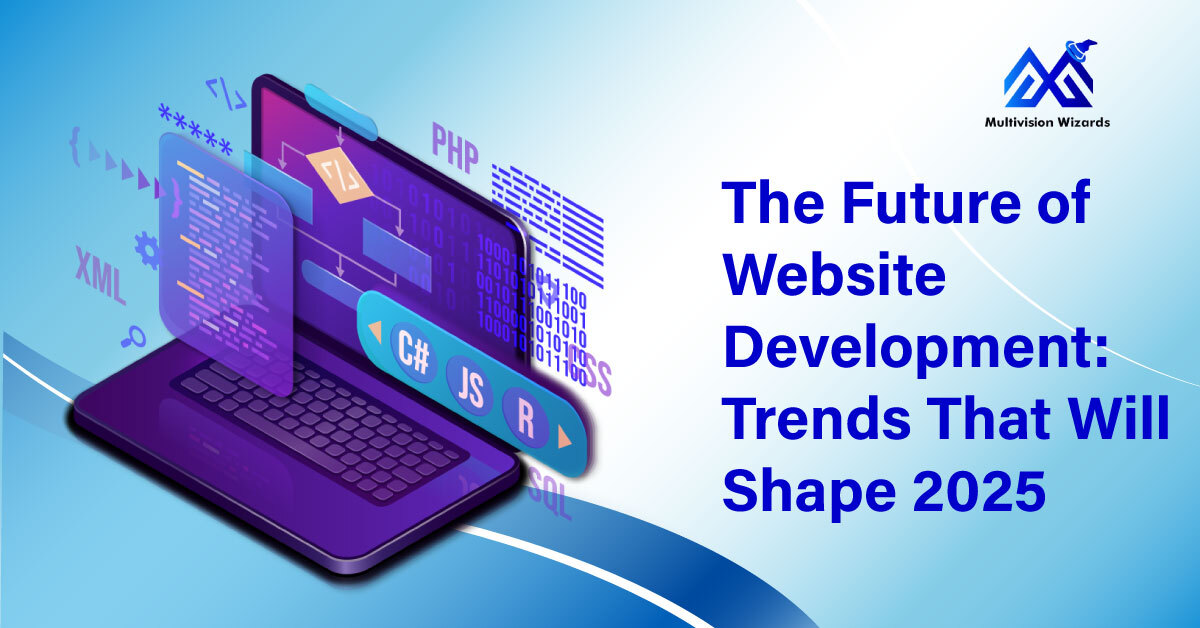The Future of Website Development
In the digital economy, your website is your most valuable business asset. It is the first interaction many customers have with your brand—and often the deciding factor in whether they engage, buy, or leave. As we step into 2025, website development is not just a backend function; it’s a strategic growth enabler.

Website Development Is No Longer Just About Code
For modern businesses, staying relevant online means building websites that are faster, smarter, more personalised, and deeply integrated into the broader customer journey. At Multivision Wizards, we believe that the future of website development is driven by user expectations, technology innovation, and performance-first thinking.
This extended guide covers the key website development trends in 2025 that every business should understand—and implement—to stay competitive and future-ready.
1. AI-Driven Web Experiences: Personalisation in Real-Time
Artificial Intelligence is no longer reserved for enterprise tech—it’s rapidly entering the core of modern website development. AI-powered websites are transforming how users interact with digital content. From predictive search to automated product suggestions, chatbots to voice interfaces, AI enhances every step of the user experience.
In 2025, users expect smart websites that “understand” their needs. Businesses are adopting AI to:
- Display personalised product recommendations
- Adapt site layouts based on user behaviour
- Automate real-time customer support
- Trigger dynamic content based on geolocation or browsing history
Key Impact: AI makes websites more intuitive, responsive, and customer-centric—improving engagement rates and increasing time on site.
2. Core Web Vitals Dominate SEO and User Trust
Google continues to emphasise Core Web Vitals as a ranking factor. These vitals—Largest Contentful Paint (LCP), First Input Delay (FID), and Cumulative Layout Shift (CLS)—are direct measures of how fast, stable, and user-friendly a website is.
As SEO becomes more technical, your website development approach must address these performance metrics from the ground up. Fast-loading pages, optimised assets, minimal layout shifts, and clean coding structures are now essential—not optional.
Key Impact: Websites that ignore Core Web Vitals risk losing both search visibility and user trust, directly impacting conversions and brand perception.
3. Mobile-First Development Is the New Default
With smartphones accounting for over 70% of global web traffic, mobile-first design is no longer a trend—it’s the foundation of effective web development. In 2025, websites are not just “responsive” but are strategically built for mobile users first, then adapted for desktops.
Mobile-first website development includes:
- Prioritising vertical layouts and touch gestures
- Optimising content for smaller screens
- Compressing images and enabling lazy loading
- Ensuring seamless navigation with thumb-friendly design
Key Impact: A mobile-optimised experience boosts retention, improves SEO, and drives more conversions in mobile-heavy industries like e-commerce, education, and local services.
4. Voice Search Compatibility: Websites That Listen
As voice search grows across smartphones, smart speakers, and cars, websites must be ready to handle voice-driven queries. This affects how content is written, structured, and retrieved.
In 2025, businesses must incorporate:
- Conversational content targeting long-tail voice queries
- FAQ schemas and structured data for voice snippets
- Natural language search features on-site
- Integration with voice assistants for product search or bookings
Key Impact: Voice-optimised website development improves discoverability and future-proofs your brand’s visibility in evolving search landscapes.
5. Headless CMS & API-First Architecture for Scalability
Traditional CMS platforms are being replaced by headless CMS and API-first website development structures. This modular architecture separates the frontend from the backend, allowing businesses to manage content across multiple platforms (web, mobile, apps, kiosks) without duplicating efforts.
Benefits of headless and API-driven development include:
- Greater flexibility in design and user interfaces
- Faster development cycles with reusable components
- Scalable performance across devices and channels
- Future-readiness for omnichannel digital experiences
Key Impact: This trend empowers businesses to stay agile, launch faster, and deliver consistent experiences everywhere the user interacts with the brand.
6. Web Accessibility and Inclusive Design Take Priority
In 2025, website accessibility is both a social responsibility and a legal requirement in many markets. Inclusive web development ensures that your website can be used by people with disabilities, including visual impairments, motor limitations, and cognitive challenges.
Key practices include:
- Adding alt-text for images
- Using high-contrast colour schemes
- Designing keyboard-navigable interfaces
- Ensuring screen reader compatibility
- Meeting WCAG 2.1 standards
Key Impact: An accessible website builds trust, reaches a wider audience, and complies with legal standards—while also improving your SEO.
7. Progressive Web Apps (PWAs): The App-Like Web Experience
Progressive Web Apps are fast, installable, and offer offline capabilities. They bridge the gap between websites and native apps without the need for separate downloads or platform-specific development.
PWAs load instantly, work offline, and support push notifications—making them ideal for service-based platforms, e-commerce, and news websites.
Benefits of PWAs:
- Reduced bounce rates with near-instant loading
- Increased engagement and session time
- App-like experience without downloading
- Lower development costs and faster deployment
Key Impact: PWAs represent the next wave of performance-focused website development, especially for businesses that want to maximise reach without building native apps.
8. Motion UI and Microinteractions: Enhancing User Flow
In 2025, microinteractions—such as animated buttons, scroll effects, and transition feedback—play a key role in improving user experience. These subtle design touches guide users through the site, make actions feel responsive, and bring digital interfaces to life.
Examples of microinteractions include:
- A like button animation
- Navigation transitions
- Hover effects on product tiles
- Form validation animations
Key Impact: Microinteractions reduce cognitive load, boost user satisfaction, and create a polished, modern user interface that reflects professionalism and brand quality.
9. Data Privacy and Secure Development Practices
With rising concerns around data protection, secure website development is a growing priority. Users are more cautious about where and how their data is collected, stored, and used.
In 2025, businesses must implement:
- GDPR-compliant data policies
- SSL certificates across all pages
- Secure payment gateways and encryption
- Regular security audits and code reviews
Key Impact: A secure website protects user trust, prevents data breaches, and ensures long-term brand credibility.
10. Real-Time Features & Interactive Content
The modern user expects real-time experiences—whether it’s live chat, product availability, pricing updates, or in-page feedback.
Interactive and real-time elements include:
- Real-time chat support
- Live event countdowns
- Interactive calculators
- Custom product configurators
Key Impact: Websites that interact in real time with users create a more immersive, valuable experience that increases dwell time and conversions.
Conclusion: The Future of Website Development is Smart, Seamless, and Strategic
In 2025, website development is not about just building pages—it’s about building digital ecosystems that are fast, intelligent, secure, and user-obsessed.
From AI integrations and headless structures to mobile-first design and accessibility, these trends are not passing fads—they are the new foundations of a high-performing, future-ready digital presence.
Whether you're a startup, D2C brand, or established enterprise, embracing these trends in your web development strategy will help you stay ahead, drive better performance, and deliver long-term value to your audience.


